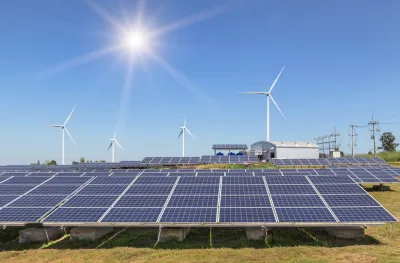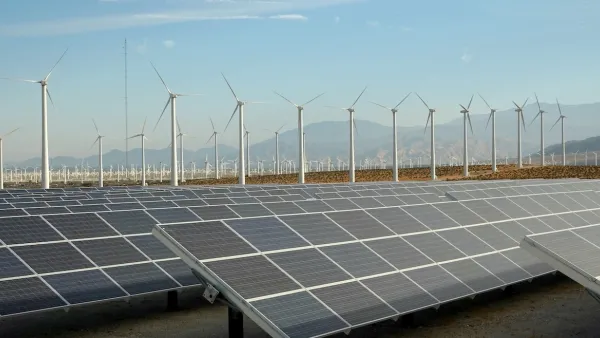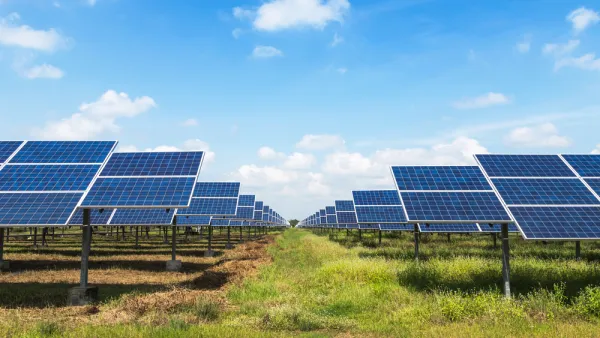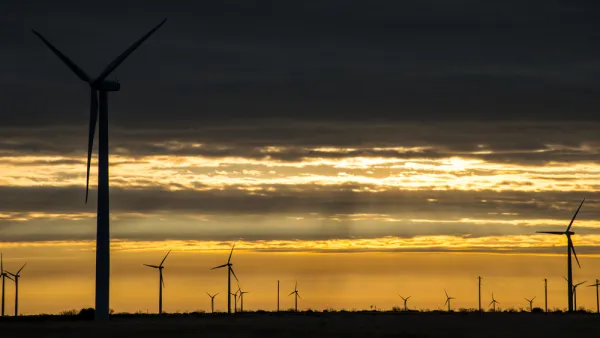As more wind and solar plants get built in remote locations, utilities must figure out how to transport and store energy over increasingly vast distances.

Renewable energy sources are slowly gaining a foothold in the United States, but as Gregory Barber writes, our electric grid isn't quite ready for them. "Since 1889, when the US got its first long-distance power line (it traversed a whopping 14 miles), the grid largely has been set up for energy that’s consumed relatively close to where it is produced." But with renewables like wind and solar requiring vast swaths of space in far-off places, utility companies will have to improve their ability to harness and transport that power to where it's needed.
According to Princeton researchers, meeting national clean energy goals requires increasing the nation's high-voltage transmission capacity by 60 percent. Today, some production facilities are actually forced to shut down when they are producing too much power to transmit over outdated wires.
For plants that are yet to be built, the situation is even worse, because grid constraints mean backers must string new lines, and pay for them, before installing turbines or solar panels. Each year, hundreds of renewable energy projects stall in advanced planning stages due to delays in upgrading transmission lines and the cost of making those upgrades.
Barber describes research being done into 'grid-enhancing tools' that can boost the amount of power that lines can carry and improve flexibility during variable supply and demand periods. But experts say that "[t]echnologies that enhance the existing grid are one part of a much bigger puzzle." Creating a grid that can effectively harness wind and solar energy and meet future demand while preparing for the effects of extreme weather will require a comprehensive plan spanning multiple agencies and users.
FULL STORY: Renewable Energy Is Great—but the Grid Can Slow It Down

Analysis: Cybertruck Fatality Rate Far Exceeds That of Ford Pinto
The Tesla Cybertruck was recalled seven times last year.

National Parks Layoffs Will Cause Communities to Lose Billions
Thousands of essential park workers were laid off this week, just before the busy spring break season.

Retro-silient?: America’s First “Eco-burb,” The Woodlands Turns 50
A master-planned community north of Houston offers lessons on green infrastructure and resilient design, but falls short of its founder’s lofty affordability and walkability goals.

Test News Post 1
This is a summary

Analysis: Cybertruck Fatality Rate Far Exceeds That of Ford Pinto
The Tesla Cybertruck was recalled seven times last year.

Test News Headline 46
Test for the image on the front page.
Urban Design for Planners 1: Software Tools
This six-course series explores essential urban design concepts using open source software and equips planners with the tools they need to participate fully in the urban design process.
Planning for Universal Design
Learn the tools for implementing Universal Design in planning regulations.
EMC Planning Group, Inc.
Planetizen
Planetizen
Mpact (formerly Rail~Volution)
Great Falls Development Authority, Inc.
HUDs Office of Policy Development and Research
NYU Wagner Graduate School of Public Service




























